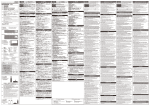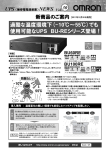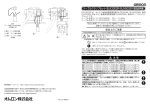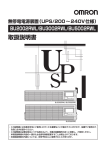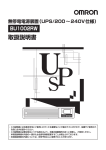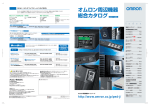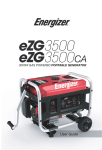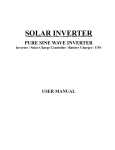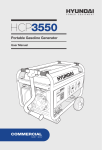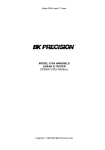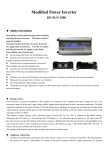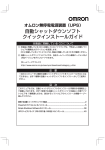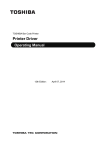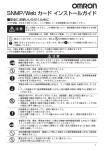Download User`s Manual
Transcript
Uninterruptible Power Supply (UPS/200-240V model) BU2002RWLG/BU3002RWLG/BU5002RWLG User’s Manual ESC BU2002RWLG/BU3002RWLG ESC BU5002RWLG • This manual provides important safety-related information. Thoroughly read and understand this manual before installing and using the product. • Keep this manual in a convenient location so that you can refer to it whenever necessary. • The contents of this manual are subject to change without notice. Introduction Features of this product Thank you for purchasing Omron's Uninterruptible Power Supply (UPS). ● The UPS protects computers and other devices from power failures, voltage variations, instantaneous voltage drops, and surge voltage such as that caused by lightning (a phenomenon in which extraordinary high voltage occurs instantaneously). ● Under normal conditions, a stable sine wave AC voltage is output by raising the voltage (when the input voltage is low) or lowering the voltage (when the input voltage is high) according to the input voltage status, in synchronization with commercial power input. In addition, a full-time inverter supply method (high efficiency) is employed; when abnormalities in commercial power are detected, such as in a power failure or when there are large changes in voltage, power supply is uninterruptedly shifted to the battery, and sine wave output is continued. ● Output capacity is 2000VA/1400W for BU2002RWLG, 3000VA/2100W for BU3002RWLG and 5000VA/3500W for BU5002RWLG. Notes on the use of the Backup Power Supply ● ● ● ● ● This product is designed and manufactured for use with FA or OA equipment such as personal computers. Do not use it when very high reliability and safety are required as listed below. • Medical equipment that may cause death directly • Applications that may cause injury (applications that directly affect the operation and control of planes, ships, railroads, and so on) • Applications that are always subjected to vibration such as cars and ships • Applications in which a failure of this product may cause significant damage or effect to the society and public (important computer systems, main communication equipment, public transportation systems, and so on) • Equipment with the same level of importance For equipment that greatly affects the safety of people and maintaining public functions, special considerations related to operation, maintenance, and management must be taken such as duplicating the system and emergency power generation facilities. Observe the contents of this manual such as the use conditions and environments. When you want to use this product for an important system that requires very high reliability, contact Omron representatives. Do not modify/alter this product. Disclaimers We are not liable for any damage or secondary damage resulting from the use of our product, including malfunction and failure of equipment, connected devices, or software. ● ● Make sure to read the safety precautions before using the unit. In the event you transfer or sell this unit to a third party, please include all of the documentation that came with this unit. This is to ensure that the unit is used in line with the conditions described in the included documentation. • This manual contains important safety-related information. Please read and understand the contents of the manual before beginning operation. If you discover any omissions or errors in the manual, please contact the shop of purchase. Windows is the registered trademark of Microsoft Corporation in the United States and/or other countries. ● The names of other companies and products mentioned herein are the trademarks or registered trademarks of their respective owners. ● ©OMRON Corporation. 2013 All Rights Reserved. i IMPORTANT SAFETY INSTRUCTION 1. SAVE THESE INSTRUCTIONS. This manual contains important instructions for BU2002RWLG/ BU3002RWLG/BU5002RWLG that should be followed when using the UPS and batteries. 2. SYMBOL This symbol indicates earth ground. This symbol indicates turning on UPS. This symbol indicates turning off UPS. 3. INTERNAL BATTERY Internal battery voltage is 48VDC for BU2002RWLG and 72VDC for BU3002RWLG/BU5002RWLG. 4. TEMPERATURE RATING The maximum ambient temperature of the UPS is 40°C. 5. ENVIRONMENT The unit is intended for installation in a temperature controlled, indoor area free of conductive contaminants. ii Procedure from installation to operation Read “Safety precautions” Page v Start Remove the product from the package and check the contents Page 1 Installation/connection Perform installation and connection Page 5 Are you using UPS monitoring software or contact signal? Yes Read “Using the UPS monitoring software and contact signal” Page 38 No Check the operation and displays Pages 21 Preparation for operation Charge the battery Page 23 Measure the backup time Page 34 Charge the battery again Page 23 * Preparation for operation is complete. Operate Page 24 Perform maintenance and inspection Page 36 Replace the battery No Deteriorated battery? Maintenance/ inspection Yes iii Table of Contents Table of Contents Introduction ......................................................................................................................................... i IMPORTANT SAFETY INSTRUCTION ................................................................................................ ii Safety precautions ............................................................................................................................. v 1. Preparation .....................................................................................................................................1 1-1 1-2 1-3 Unpacking the product ........................................................................................................................ 1 Name of each part ............................................................................................................................... 2 Explanation of symbols used on unit................................................................................................... 4 2. Installation and connection ............................................................................................................5 2-1 2-2 2-3 2-4 2-5 2-6 2-7 2-8 Precautions and notes on installation and connection ...................................................................................................... 5 Installation ........................................................................................................................................... 9 Connecting the equipment ................................................................................................................ 14 Connecting the AC input ................................................................................................................... 18 Checking the operation ..................................................................................................................... 21 Charging the battery .......................................................................................................................... 23 Measuring the initial value of backup time ........................................................................................ 23 Recharging the battery ...................................................................................................................... 23 3. Operation......................................................................................................................................24 3-1 3-2 3-3 Precautions and notes for operation ................................................................................................. 24 Start and stop procedures and basic operation ........................................................................................ 26 Interpreting beeps and displays ................................................................................................................ 29 4. UPS functions ..............................................................................................................................30 4-1 4-2 4-3 4-4 Suspending a beep............................................................................................................................ 30 Self-diagnosis test ............................................................................................................................. 30 Battery life counter function .............................................................................................................. 31 Operation panel setting ..................................................................................................................... 31 5. Measuring the backup time ..........................................................................................................34 5-1 5-2 How to measure backup time............................................................................................................ 34 Estimated backup time ...................................................................................................................... 34 6. Maintenance and Inspection ........................................................................................................36 6-1 6-2 Checking the battery ......................................................................................................................... 36 Cleaning ............................................................................................................................................. 37 7. Using the UPS monitoring software and contact signal ..............................................................38 7-1 7-2 When using the included UPS monitoring software to perform auto shutdown ............................... 40 Contact signal.................................................................................................................................... 42 8. Troubleshooting ............................................................................................................................45 References .......................................................................................................................................46 A. Specifications ......................................................................................................................................... 46 B. Dimensions............................................................................................................................................. 47 C. Circuit block diagram ............................................................................................................................. 51 D. Related products .................................................................................................................................... 51 iv Safety precautions Important information for safe operation is described. Be sure to read it before installation and start of use. ● The safety symbols and their meaning used in this manual are as follows: Warning Misuse may cause death or serious injury. Caution Misuse may cause injury or property damage. * Property damage means damage to houses/household effects, livestock, and pets. : Indicates prohibition. For example, indicates that disassembly is prohibited. : Indicates obligation. For example, indicates that grounding is necessary. Note that events categorized as a caution required matter also may cause more serious results under certain conditions. Warning Do not use this unit when very high reliability and safety are required as listed below. This unit is designed and manufactured for use with FA or OA equipment such as personal computers. ● Medical equipment or system that may cause death directly. ● Applications that directly affect the safety of people (For example, the operation and control of cars). ● Applications in which a failure of the unit may cause significant damage to the society and public (For example, essential computer systems and main communication equipment.) ● Applications with the same level of importance. Caution (for installation and connection) Carry the unit considering its weight and balance, and place it on a stable and robust base. ● Dropping or toppling the unit may cause injury. ● The approximate weights of the units are 28kg (BU2002RWLG), 33kg (BU3002RWLG) and 61kg (BU5002RWLG). ● If you drop the unit, stop using it and have it inspected and repaired. For repair, contact Omron representatives. Do not hold the side of the front panel when lifting. ● Injury may result if the panel comes off and falls. Keep plastic package bags out of reach of children. ● Children may suffocate if they place their heads into plastic bags. Make sure to connect the unit’s AC input plug to a commercial power source with rated input voltage (200/208/220/230/240VAC) and 50/60 Hz frequency. ● Connecting to a commercial power source with a different rated input voltage or frequency may result in a fire. ● The unit may fail. v Safety precautions Caution (for installation and connection) For BU5002RWLG, when an abnormality (unusual sound or smell) occurs, disconnect the AC input plug from the wall outlet, or turn OFF the INPUT PROTECTION switch (input overcurrent protection switch) on the back of the unit. The socket-outlet shall be installed near the equipment and shall be easily accessible. For BU2002RWLG and BU3002RWLG, turn OFF the external breaker installed on the input side. ● When performing maintenance on the connected devices, follow the above instructions to ensure safety. Do not connect devices such as dryers, some solenoid valves, etc., which have a half-wave rectifier that allows only half-cycle AC power to flow through. ● Overcurrent may damage the UPS. Connect the unit to a wall outlet (commercial power) with the appropriate capacity (11A or greater for BU2002RWLG, 16A or greater for BU3002RWLG and 27A or greater for BU5002RWLG). ● Otherwise, the power cord may be heated. ● When equipment with the maximum output capacity is connected, a maximum current of 11A (BU2002RWLG), 16A (BU3002RWLG), or 27A (BU5002RWLG) flows. When changing the input cable, make sure to perform the connection as specified. ● When connecting a cable to the terminal block, use a cable that complies with the input current specification of the UPS. ● Failure to do so may result in electric shock or ground fault. When in use, make sure the output terminal block cover is attached. Do not turn ON the power switch when it is detached. ● Voltage is applied to the output terminal block when the power switch is ON, which can result in electric shock. Provide secure grounding. ● For AC input plug connection, connect the plug directly to a commercial power source. For termi- nal block connection, connect the cable to a commercial power source and ground it. A failure or leak that occurs when the unit is not properly grounded may result in electric shock. Do not disassemble, repair, or modify the unit. ● Doing so may cause an electric shock or a fire. Do not install the unit in other than specified orientations. ● Dropping or toppling the unit may cause injury. ● If you install the unit in an orientation other than specified, the unit cannot be protected from a battery fluid leakage. ● Use the included vertical stand when positioning the unit vertically. Do not use the unit where the maximum temperature exceeds 40°C. ● The battery deteriorates rapidly. ● Doing so may cause a failure or malfunction of the unit. vi Caution (for installation and connection) Do not exceed the ranges specified for environmental conditions during use/storage. Do not install or store the unit in the places listed below. ● Do not store in places where the humidity is lower than 10% or higher than 90%. ● Do not use the unit in places where the ambient temperature is lower than 0°C or higher than 40°C. (With no condensation) ● Do not use in places where the humidity is lower than 10% or higher than 90%. ● Do not install/store the unit in closed places such as cabinets with no clearance, places where there is flammable or corrosive gas, places with large amounts of dust, places exposed to direct sunlight, places exposed to shock or vibration, salty or wet places, or outdoors. ● Installation or storing the unit in such a place may cause a fire. Do not connect equipment that exceeds the output capacity of the unit. You can use plug strip to connect additional devices, but do not connect devices that exceed the current capacity of the plug strip. ● The current protection of the unit may operate, which may stop the output. ● The wiring of the plug strip heats up, which may cause a fire. Do not pinch or sharply bend the cable. Do not fold or knot the cable. ● Doing so may cause the cable to be damaged or heated, which may cause an electric shock or a fire. ● If the cable is damaged, stop using the unit and have the cable repaired. ● For repair, contact Omron representatives. All of the included accessories are designed to be used exclusively with the unit. Do not use the accessories with other devices. ● Doing so may compromise the safety of devices. Do not block the air vents (front and rear). ● Doing so will cause the internal temperature to rise, which may cause the unit to fail and the bat- tery to deteriorate. ● Leave at least 5 cm of space between the front vent and the wall, and at least 10 cm of space between the rear vent and the wall. Do not connect devices that cannot be used with commercial power supply. ● When the unit’s power switch is turned ON and an error occurs with the connected device, by- pass operation is performed and commercial power supply is supplied as is to the connected devices. When installing the unit on a rack, place it on the lower shelf. ● Injury may result if the unit falls. Make sure to use the mounting screws included with the brackets. ● Mounting screws other than those included may not be strong enough to support the unit, caus- ing it to fall. ● If you attach the case using long screws other than those included with the product, you may damage the internal parts of the unit. When using the unit in the 100V output mode, check that the output voltage is set to 100V, and then turn ON the power switch. ● Connecting a 100V device to the unit while outputting in the 200V mode may cause a failure of the device or a fire. ● The output voltage can be set with “Settings” - “In/Out Settings” - “Output Voltage” in the menu on the LCD. vii Safety precautions Caution (for use) Do not allow the unit to come in contact with water. If you drop the unit, stop using it. ● Doing so may cause an electric shock or a fire. ● If the unit becomes wet or is dropped, immediately stop using it, disconnect the AC input cable from commercial power and have the unit inspected and repaired. ● For repair, contact Omron representatives. When the battery is dead, replace it immediately or stop using the unit. ● Continuing the use of it may cause fire or electric shock due to liquid leaks. Ambient temperature 25°C 35°C Expected life 5 years 2.5 years * The values in the table are the expected life under standard use conditions and are not guaranteed. Using a dry cloth, periodically wipe the dust from the AC input plug, input terminal block and power supply output receptacles. ● Accumulated dust may cause a fire. Do not use the unit in a closed place and do not cover the unit. ● Doing so may cause abnormal heating or a fire. ● Depending on the operating environment, hydrogen gas may be generated from the battery, re- sulting in a rupture or explosion. Ventilate the area around the unit. If you notice an abnormal sound or smell, smoke, or leaking fluid, immediately turn OFF the unit's power switch and stop the supply of commercial power. ● Using the unit under such conditions may cause a fire. ● If you notice such a condition, stop using the unit and contact Omron representatives. for inspection and repairs. ● Position the unit in such a way that you can immediately disconnect the AC input plug from the wall outlet (commercial power) in the event a problem occurs. If fluid leaks from the unit, do not touch the fluid. ● Doing so may cause blindness or burns. ● If the fluid contacts your eyes or skin, wash it out with lots of clean water and consult your doctor. Do not place objects heavier than 25 kg on the unit, and do not drop heavy objects onto the unit. ● Doing so may cause distortion/damage to the case or a failure of the internal circuit, which may cause a fire. The unit is equipped with a bypath circuit which is able to supply electric power to connected devices even when the inner control circuit is broken down by defects or malfunctions ● Output is continuing even when all indicators of the front panel are off. ● If you want to stop the output, either stop the source of commercial power or disconnect the AC input plug from the wall outlet (commercial power). Do not sit or stand on top of the product, use it as a step ladder, or lean against it. ● Doing so may cause the unit to fail or to fall over and result in injury. viii Caution (for maintenance) When maintaining the connected equipment, turn OFF the unit’s power switch to stop the output, and stop the supply of commercial power. ● Even if commercial power to the UPS is stopped while it is in operation, the power output of this unit does not stop and power is supplied from the receptacle. Do not disassemble, repair, or modify the unit. ● Doing so may cause an electric shock or a fire. If fluid leaks from the unit, do not touch the fluid. ● Doing so may cause blindness or burns. ● If the fluid contacts your eyes or skin, wash it out with lots of clean water and consult your doctor. Do not throw the unit into fire. ● The lead battery in the unit may explode, or leak dilute sulfuric acid. Do not insert metal objects into the power supply output receptacle of the UPS. ● Doing so may result in electric shock. Do not insert metal objects into the battery connectors. Do not create a short between the connector terminals. ● Doing so may result in electric shock. Caution (for battery replacement) Perform replacement on a stable and flat place. ● Handle the battery carefully so that you do not drop it. ● Not doing so could cause injury or burns due to liquid (acid) leakage. Use a specified battery for replacement. ● Not doing so may cause a fire. ● Replacement battery pack for BU2002RWLG: BUB2002RWG BU3002RWLG: BUB3002RWG BU5002RWLG: BUB3002RWG (2PCS.) Do not replace the battery in a place where there is flammable gas. ● Spark may occur when connecting the battery, which may cause an explosion or fire. If fluid (dilute sulfuric acid) leaks from the battery, do not touch the fluid. ● Doing so may cause blindness or burns. ● If it contacts your eyes or skin, wash it out with lots of clean water and consult your doctor. Do not disassemble or modify the battery. ● Doing so could cause dilute sulfuric acid leak, which could cause blindness and burns. Do not drop the battery and do not expose it to strong impact. ● Dilute sulfuric acid may leak. Do not short the battery with metal objects. ● Doing so could cause an electric shock, fire or burn. ● Some electrical energy still remains inside the spent battery. Do not put the battery into fire and do not break it. ● The battery may explode or leak dilute sulfuric acid. Do not use a new battery and an old battery at the same time. ● Dilute sulfuric acid may leak. ix Safety precautions Notes When moving the unit from a cold place to a warm place, leave it for several hours before using it. ● If the unit is promptly turned ON after being moved to a warmer place, condensation may form inside the unit and cause it to fail. Charge the battery soon after purchasing the unit. ● If you do not use the unit for a long time after the purchase, the battery may deteriorate and the battery may become unusable. ● The battery can be charged once the AC input plug is connected to commercial power. Recharge the battery for at least 8 hours every 6 months when the storage temperature is 25°C or less, or every 2 months when the storage temperature is 40°C or less. ● The battery self-discharges even when it not being used, and it goes into over-discharge state if it is left for a long period of time. The backup time may become shorter or the battery may become unusable. ● We recommend keeping the temperature 25°C or less when storing the unit for long periods of time. ● Turn OFF the unit’s power switch when storing it. Do not short the output lines of the unit to each other, and do not short the output lines to the ground. ● The unit may fail. Do not connect the AC input terminal of the unit to its Power Supply Output terminal during the Battery Mode. ● The unit may fail. Do not connect a page printer (such as a laser printer) to the unit. ● The unit repeatedly and frequently switches between Commercial Power Mode and Battery Mode, which may shorten the life of the battery. ● The page printer has a large peak current, so an excess of the connection capacity or a power failure due to instantaneous voltage drop may be detected. Do not install or store the unit in a place exposed to direct sunlight. ● The rise of temperature may cause the built-in battery to deteriorate rapidly and become unusable. Do not perform withstand voltage tests. ● Performing withstand voltage tests may damage the surge absorption element built into the power supply input circuit. ● When performing an insulation resistance test, use the 400 VDC range. Before stopping the commercial power to the unit, turn OFF the power switch of the unit. ● The unit enters Battery Mode when commercial power is stopped. If you frequently use the unit in Battery Mode, the battery life may be significantly shortened. If this unit is used for an inductive device such as a coil or motor, check the operation beforehand. ● With some types of devices, the effect of inrush current may cause this unit to stop operating properly. x Notes Check system operation beforehand if the unit is used in combination with a device whose power supply voltage and frequency fluctuate widely, such as a generator. ● If the generator’s output voltage/frequency falls out of the input voltage/frequency range, the unit will enter Battery Mode. ● Even if the input frequency is within the range, the unit will enter Battery Mode when a rapid change (5 Hz/sec or greater) occurs. In the event you transfer or sell this unit to a third party, please include all of the documentation that came with the unit. This is to ensure that the unit is used in line with the conditions described in the included documentation. ● This manual contains important safety-related information. Please read and understand the contents of the manual before beginning operation. This unit uses lead acid batteries, ● Which are a valuable recyclable resource. Please recycle. Pb Take measures for handling unforeseen accidents, such as data backup and system redundancy. ● The output may stop when there is a circuit failure in the UPS. Explanation Usual operation ● You may either leave the power switch of the unit ON (operation status) or turn it OFF each time when stopping the connected system. Choose whichever operation method is more convenient. We recommend turning OFF the power switch when you do not use connected devices for a long time. ● The battery can be charged once the unit is connected to a commercial power source. Quitting Battery Mode ● If a power failure lasts for an extended period of time, the battery discharges completely and power output from the unit stops. Shut down your computer after performing appropriate procedures (for example, saving data) while the unit is still supplying power. Rebooting ● If the battery discharges completely during a power failure, the output stops. After recovery from the power failure, the unit automatically restarts and output begins. If you do not want to restart the connected devices, disable the “Settings” - “Boot Settings” - “Auto reboot” setting in the menu on the unit’s LCD, or turn OFF the power switch of the connected devices. Scheduled operation using the UPS monitoring software ● When performing scheduled operation in which the UPS is stopped and a device such as a breaker is used to stop the UPS at the same time that commercial power stops, specify a period of no more than 3 months for the start of the next operation. If you specify a period longer than 3 months, the internal timer is reset and the scheduled operation does not start. Note that this period reduces to approximately half when the battery needs to be replaced. If a period of 3 months is exceeded, you start operation by supplying commercial power and pressing the start switch. However, if the battery needs to be replaced, you may not be able to start operation. In this case, replace the battery. xi 1 Preparation 1-1 Unpacking the product Caution The approximate masses of the units are 28kg (BU2002RWLG), 33kg (BU3002RWLG) and 61kg (BU5002RWLG) . Since the unit is heavy, be careful not to hurt yourself when lifting or transporting it. Hold the handle of the inner packaging when taking out the product from the package box. ● Hold the handle of the inner packaging when taking out the product from the package box. ● Dropping may cause injury. Open the package box and take out the UPS and accessories. 1 BU2002RWLG/BU3002RWLG/BU5002RWLG 1-2 Name of each part This section describes the name of each part of the UPS. For information on the function of each part, refer to "2. Installation and connection" on page 5 and "3. Operation" on page 24 that provides the details. Front view < BU2002RWLG/BU3002RWLG > <Air vent> 1 <Operation panel> ESC < BU5002RWLG > <Air vent> <Operation panel> ESC < Enlarged view of the operation panel > A A. B. C. D. E. F. G. H. I. B C D E ESC F G H Power supply output lamp Battery mode lamp Battery replacement lamp LCD for status and setting display Power switch ESC switch Up switch Down switch Enter switch I 2 1.Preparation Rear view < BU2002RWLG > A B D E F G E F G C < BU3002RWLG > A B D D C < BU5002RWLG > B A C D I H A. B. C. D. E. 3 Option slot Contact signal port RS-232C port Cooling fan AC input terminal block F. G. H. I. I F G AC output terminal block AC input overcurrent protection switch AC input cable AC output receptacle BU2002RWLG/BU3002RWLG/BU5002RWLG 1-3 Explanation of symbols used on unit Symbol Description Start the UPS. Stop the UPS. Suspend a beep. 1 UPS output power enabled, supplied by operating on line mode, battery mode. Bypass output “ON”. UPS output power enabled, supplied by operating on battery mode. Batteries at end of useful life, necessary to replace the batteries. 4 2 Installation and connection 2-1 Precautions and notes on installation and connection Caution (for installation and connection) Carry the unit considering its weight and balance, and place it on a stable and robust base. ● Dropping or toppling the unit may cause injury. ● The approximate weights of the units are 28kg (BU2002RWLG), 33kg (BU3002RWLG) and 61kg (BU5002RWLG). ● If you drop the unit, stop using it and have it inspected and repaired. For repair, contact Omron representatives. Do not hold the side of the front panel when lifting. ● Injury may result if the panel comes off and falls. Keep plastic package bags out of reach of children. ● Children may suffocate if they place their heads into plastic bags. Make sure to connect the unit’s AC input plug to a commercial power source with rated input voltage (200/208/220/230/240VAC) and 50/60Hz frequency. ● Connecting to a commercial power source with a different rated input voltage or frequency may result in a fire. ● The unit may fail. For BU5002RWLG, when an abnormality (unusual sound or smell) occurs, disconnect the AC input plug from the wall outlet, or turn OFF the INPUT PROTECTION switch (input overcurrent protection switch) on the back of the unit. The socket-outlet shall be installed near the equipment and shall be easily accessible. For BU2002RWLG and BU3002RWLG, turn OFF the external breaker installed on the input side. ● When performing maintenance on the connected devices, follow the above instructions to ensure safety. Do not connect devices such as dryers, some solenoid valves, etc. , which have a half-wave rectifier that allows only half-cycle AC power to flow through. ● Overcurrent may damage the UPS. Connect the unit to a wall outlet (commercial power) with the appropriate capacity (11A or greater for BU2002RWLG, 16A or greater for BU3002RWLG and 27A or greater for BU5002RWLG). ● Otherwise, the power cord may be heated. ● When equipment with the maximum output capacity is connected, a maximum current of 11A (BU2002RWLG), 16A (BU3002RWLG), or 27A (BU5002RWLG) flows. When changing the input cable, make sure to perform the connection as specified. ● When connecting a cable to the terminal block, use a cable that complies with the input current specification of the UPS. ● Failure to do so may result in electric shock or ground fault. 5 BU2002RWLG/BU3002RWLG/BU5002RWLG Caution (for installation and connection) When in use, make sure the output terminal block cover is attached. Do not turn ON the power switch when it is detached. ● Voltage is applied to the output terminal block when the power switch is ON, which can result in electric shock. Provide secure grounding. ● For AC input plug connection, connect the plug directly to a commercial power source. For termi- nal block connection, connect the cable to a commercial power source and ground it. A failure or leak that occurs when the unit is not properly grounded may result in electric shock. Do not disassemble, repair, or modify the unit. ● Doing so may cause an electric shock or a fire. Do not install the unit in other than specified orientations. ● Dropping or toppling the unit may cause injury. ● If you install the unit in an orientation other than specified, the unit cannot be protected from a battery fluid leakage. Do not use the unit where the maximum temperature exceeds 40°C. ● The battery becomes weak rapidly, which may cause a fire. ● Doing so may cause a failure or malfunction of the unit. Do not exceed the ranges specified for environmental conditions during use/storage. Do not install or store the unit in the places listed below. 2 ● Do not store in places where the humidity is lower than 10% or higher than 90%. ● Do not use the unit in places where the ambient temperature is lower than 0°C or higher than 40°C. (With no condensation) ● Do not use in places where the humidity is lower than 10% or higher than 90%. ● Do not install/store the unit in closed places such as cabinets with no clearance, places where there is flammable or corrosive gas, places with large amounts of dust, places exposed to direct sunlight, places exposed to shock or vibration, salty or wet places, or outdoors. ● Installation or storing the unit in such a place may cause a fire. Do not connect equipment that exceeds the output capacity of the unit. You can use a plug strip to connect additional devices, but do not connect devices that exceed the current capacity of the plug strip. ● The current protection of the unit may operate, which may stop the output. ● The wiring of the plug strip heats up, which may cause a fire. Do not pinch or sharply bend the cable. Do not fold or knot the cable. Doing so may cause the cable to be damaged or heated, which may cause an electric shock or a fire. ● If the cable is damaged, stop using the unit and have the cable repaired. For repair, contact Omron representatives. The accessories are designed exclusively for use with this unit. Do not use any of the included accessories with other devices. ● Doing so may compromise the safety of devices. Do not block the air vents (front and rear). ● Doing so will cause the internal temperature to rise, which may cause the unit to fail and the bat- tery to deteriorate. ● Leave at least 5 cm of space between the front vent and the wall, and at least 10 cm of space between the rear vent and the wall. 6 2.Installation and connection Caution (for installation and connection) Do not connect devices that cannot be used with commercial power supply. ● When the unit’s power switch is turned ON and an error occurs with the connected device, by- pass operation is performed and commercial power supply is supplied as is to the connected devices. When installing the unit on a rack, place it on the lower shelf. ● Injury may result if the unit falls. Make sure to use the mounting screws included with the brackets. ● Mounting screws other than those included may not be strong enough to support the unit, caus- ing it to fall. ● If you attach the case using long screws other than those included with the product, you may damage the internal parts of the unit. When using the unit in the 100V output mode, check that the output voltage is set to 100V, and then turn ON the power switch. ● Connecting a 100V device to the unit while outputting in the 200V mode may cause a failure of the device or a fire. ● The output voltage can be set with “Settings” - “In/Out Settings” - “Output Voltage” in the menu on the LCD. 7 BU2002RWLG/BU3002RWLG/BU5002RWLG Notes When moving the unit from a cold place to a warm place, leave it for several hours before using it. ● If the unit is promptly turned ON after being moved to a warmer place, condensation may form inside the unit and cause it to fail. Charge the battery soon after purchasing the unit. ● The battery self-discharges even when it not being used, and it goes into over-discharge state if it is left for a long period of time. ● The battery can be charged once the AC input plug is connected to a commercial power source. When storing the unit, charge the battery for at least 8 hours and turn OFF the power switch. ● Even if the unit is not used, the battery gradually discharges, and if it is left for a long time, it goes into an over discharge state. The backup time may become shorter or the battery may become unusable. ● Connect the unit to a commercial power source for at least 12 hours every 6 months when the storage temperature is 25°C or less, or every 2 months when the storage temperature is 40°C or less. ● Turn off the power switch of the unit during storage. Do not short the output lines of the unit to each other, and do not short the output lines to the ground. ● The unit may fail. 2 Do not connect the AC input plug of the unit to its Power Supply Output Receptacle during the Battery Mode. ● The unit may fail. Do not connect a page printer (such as a laser printer) to the unit. ● The unit repeatedly and frequently switches between Commercial Power Mode and Battery Mode, which may shorten the life of the battery. ● The page printer has a large peak current, so an excess of the connection capacity or a power failure due to instantaneous voltage drop may be detected. Do not install or store the unit in a place exposed to direct sunlight. ● The rise of temperature may cause the built-in battery to deteriorate rapidly and become unusable. Do not perform withstand voltage tests. ● Performing withstand voltage tests may damage the surge absorption element built into the power supply input circuit. ● When performing an insulation resistance test, use the 400 VDC range. Before stopping the commercial power to the unit, turn OFF the power switch of the unit. ● The unit enters Battery Mode when commercial power is stopped. If you frequently use the unit in Battery Mode, the battery life may be significantly shortened. If this unit is used for an inductive device such as a coil or motor, check the operation beforehand. ● With some types of devices, the effect of inrush current may cause this unit to stop operating properly. The battery contains dilute sulfuric acid which is a toxic substance. If fluid leaks from the battery, do not let it contact your skin or clothes. If contacted, wash it out with clean water. In particular, if the fluid gets in your eyes, immediately wash them with clean water and seek medical treatment. Check system operation beforehand if the unit is used in combination with a device whose power supply voltage and frequency fluctuate widely, such as a generator. ● If the generator’s output voltage/frequency falls out of the input voltage/frequency range, the unit will enter Battery Mode. ● Even if the input frequency is within the range, the unit will enter Battery Mode when a rapid change (5 Hz/sec or greater) occurs. 8 2.Installation and connection 2-2 Installation The UPS permits the following installing methods. Choose the one best suited for the environment. 2-2-1. Rackmount installation 2-2-2. Stationary installation ● Horizontal ● Upright intatllation Do not use this unit in any position other than the “correct positions” indicated in the illustration below. Note Before installing this device, make a record of the serial number of this device. The product serial number is required when contacting us about the device. The serial number (S/N) is inscribed on the bottom left side of the rear panel. The product serial number is inscribed on the bottom left side of the rear panel. The product serial number label is also included. Correct Positions ESC )LJHYLM\SUV[[VNL[`V\YÄUNLYZJH\NO[ ^OLUHYYHUNPUN[OL\UP[ ESC ESC Incorrect Positions ESC 9 BU2002RWLG/BU3002RWLG/BU5002RWLG 2-2-1. Rackmount installation (EIA /JIS 19-inch rack/server rack) Caution When performing rack installation, ensure that the UPS is supported and stabilized by using both the support angles and the table clamps that were included. ● When installing on a rack, make sure that the UPS is supported by the each unit individually. ● When installing on a rack, make sure to use the support angles and table clamps included with the product. Without the support angles, the front clamp alone cannot support the weight of the UPS. BU3002RWLG: Approx. 33kg BU5002RWLG: Approx. 61kg ● The mass of each unit: BU2002RWLG: Approx. 28kg In a case where the UPS is to be mounted on a rack, place it on the lower part of the rack. ● Dropping it may result in injury. Be sure to use the supplied mounting screws. ● Use of long screws other than those supplied for case mounting may damage inside the unit. ● Screws other than those supplied may not be strong enough to support the UPS, causing it to fall. ● Items included in the 19-inch rack support angle mounting bracket set Rack rail (front) L/R ........................................1 each Rack rail (rear) L/R .........................................1 each Unit guide rail L/R ..........................................1 each Ear bracket L/R ..............................................1 each Spacers .................................................................. 2 2 Bracket mounting screws (M4) ................ ............ 10 EIA/JIS rack fixing screws (M5) ........................... 10 EIA rack fixing nuts (M5) ...................................... 10 ● Rack mounting procedure (1) Insert the 2 included bracket mounting screws (M4) and half-tighten them to hold the front and rear rack rails in place. ① There are two types of front and rear rack rails: left (L) and right (R). ① IYHJRL[Ä_PUN screws (M4) 10 2.Installation and connection (2) Adjust the length of support angles to suit the server rack, and then securely tighten the screws that were half-tightened in step 1. ② (3) For EIA standard-compliant installation, use the included EIA rack fixing nuts (M5) and EIA/ JIS rack fixing screws (M5) to securely fasten the front and the back of the rack rails to the server rack. ③ The screw hole positions are as follows. • EIA rack : Topmost one for the front, topmost and bottommost ones for the rear • JIS rack : One at the second from the bottom for both front and rear ③ (KQ\Z[[OLSLUN[O[V Z\P[[OLZLY]LYYHJR HUK[PNO[LUZLJ\YLS` ② ③ 9HJRÄ_PUNZJYL^Z (4) Use the 8 included bracket fixing screws (M4) (2 sets of 4 screws) to securely fasten the ear brackets and unit guide rails to the left and right sides of the UPS. ④ (Installation is possible without removing the handles on the sides of BU5002RWLG; do not remove them.) ④ ④ The support angles cannot be attached to special EIA/JIS racks. 11 BU2002RWLG/BU3002RWLG/BU5002RWLG (5) Place the UPS on the support angles and push it completely into the rack ⑤ , and use the included EIA/JIS rack fixing screws (M5) and spacers to securely fasten the ear brackets to the server rack. ⑥ The screw hole positions are as follows. • EIA rack : Topmost and bottommost ones on the front • JIS rack : One at the second from the top on the front Push completely in ⑤ 2 ⑥ Use the unit Ä_PUNZJYL^Z[V fasten Always use the support angles. Note The batteries for BU5002RWLG are in a separate package. Attach the batteries to the unit before installation. For the attachment procedure, refer to "6-2 Replacing the battery". 12 2.Installation and connection 2-2-2. Stationary installation Perform installation only as shown in the diagrams below. ● Horizontal installation Attach the included rubber feet for horizontal installation with the included M3 screws and position the unit horizontally. For stationary horizontal installation, make sure that this product does not slide or fall. (Installation is possible without removing the handles on the sides of BU5002RWLG; do not remove them.) ESC ● Upright installation ESC (1) Upright installation Use the upright stands included with the product. Attach the two upright stands (front and back) for BU2002RWLG and BU3002RWLG, and three (front, center, and back) for BU5002RWLG with the included screws. Keep a space of 250 mm or more above the UPS. (Installation is possible without removing the handles on the sides of BU5002RWLG; do not remove them.) Note The batteries for BU5002 G are in a separate package. Attach the batteries to the unit before installation. For the attachment procedure, refer to "6-2 Replacing the battery". 13 BU2002RWLG/BU3002RWLG/BU5002RWLG 2-3 Connecting the equipment Caution Do not connect devices with rated voltage of 200 to 240/100VAC or higher. ● The rated output voltage of this device is 200 to 240/100VAC. ● Overcurrent may damage the connected devices. 2-3-1. Connecting a device to the power supply output (AC receptacle) (BU5002RWLG only) (1) BU5002RWLG comes equipped with two “NEMA L6-30R” AC receptacles. Only devices with rated voltage of 200 to 240 VAC can be connected to these AC receptacles. Connect devices with rated voltage of 100 VAC to the AC output terminal block. (2) Connect devices you want to back up to the Power Supply Output Receptacles of the UPS. • If you need more output receptacles than those of the UPS, supply additional output receptacles. 2 < Example of connection for BU5002RWLG > NEMA L6-30P PC server 14 2.Installation and connection 2-3-2. Connecting a device to the power supply output (AC output terminal block) Caution When in use, make sure the output terminal block cover is attached. Do not turn ON the power switch when it is detached. ● Voltage is applied to the output terminal block when the power switch is ON, which can result in electric shock. When connecting a device to the output terminal block, make sure to include an emergency stop switch (ESD) between the unit and the load. ● In the event of an accident, the power supply to the device can be stopped by pressing the emergency stop switch. ● To reduce the risk of fire, connect only to an emergency stop switch (ESD) with a minimum rating of 250V/15A (BU2002RWLG), 250V/20A (BU3002RWLG), or 250V/30A (BU5002RWLG). When the unit is used in compliance with UL standards or CE marking, follow the National Electrical Code (ANSI/NFPA 70). ● Install the emergency stop switch where it is easy to operate. Emergency Stop Switch UPS Load ESD (1) Connect the devices that require backup to the power supply output terminal block of the unit. Check that one terminal block cover and three M3 screws are included in the accessories. BU2002RWLG and BU3002RWLG require two M3 screws, and BU5002RWLG requires one M3 screw. (The remaining M3 screws are spares.) Run the wires to be connected through the hole in the terminal block cover (with cable clamp). (See Figure 1.) If you have trouble running the wire through the hole, loosen the cable clamp dial by turning it counter-clockwise. Crimp the specified round terminal to the ground wire, and tighten the ground terminal screw. (See Figure 2.) Use a flat head screwdriver to loosen the terminal block screws, insert the wire stripped to the specified length into the terminal block from the bottom at an angle as far as it will go, and then retighten the terminal block screws. (See Figure 3.) The wire connected to the G terminal should be longer than the wires connected to L1 and L2. Refer to Table 1 for wire sizes. G terminal : Connect the ground wire L1 terminal : Connect the line L2 terminal : Connect the neutral line 15 BU2002RWLG/BU3002RWLG/BU5002RWLG Figure 1 BU2002RWLG/BU3002RWLG BU5002RWLG Figure 2 Crimp the round terminal to the ground wire. BU2002RWLG/BU3002RWLG : For M4 screw BU5002RWLG : For M5 screw 2 Figure 3 BU2002RWLG/BU3002RWLG INPUT 1ȭ170-278VAC 50-60Hz 15A G L2 L1 BU5002RWLG OUTPUT 1ȭ 100/200/208/ 220/230/240VAC 50-60Hz 15A G L2 INPUT G L2 OUTPUT1 25A L1 G L2 L1 L1 Table 1 BU2002RWLG BU3002RWLG Connectable wire size 0.5 to 4mm2 BU5002RWLG 1.5 to 6mm2 Amount of stripped wire 6 to 8mm 9 to 11mm Tightening torque 0.49N•m 1.18N•m Recommended cable size 2mm2 (AWG14) 3.5mm2 (AWG12) 16 2.Installation and connection (2) Attach the terminal block cover (with cable clamp) to the unit.For BU2002RWLG and BU3002RWLG, attach the cover after connecting the input cable. BU2002RWLG/BU3002RWLG Insert the upper part of the terminal block cover into the slit of the unit, and tighten it with two of the included M3 screws. Tighten the cable clamp dial to stabilize the wire. INPUT 1φ170-278VAC 50-60Hz 15A G L2 L1 OUTPUT 1φ 100/200/208/ 220/230/240VAC 50-60Hz 15A L2 G L1 BU5002RWLG Insert the tab on the left side of the terminal block cover into the slit of the input terminal block cover, and then run one of the included M3 screws through the hole on the right side of the terminal block cover and tighten it. Tighten the cable clamp dial to stabilize the wire. INPUT G L2 OUTPUT1 L1 G L2 25A L1 2-3-3. Connecting to a computer When using the included UPS monitoring software or the contact signal, use the connection cable to connect the unit to the PC. See also “7. Using the UPS monitoring software and Contact Signal” on page 38. * If you do not use the UPS monitoring software and Contact Signal, this step is not required. 17 BU2002RWLG/BU3002RWLG/BU5002RWLG 2-4 Connecting the AC input When installation and connection are complete, connect the unit’s AC input to a commercial power source. Caution Make sure to connect the AC input plug of the unit into a wall outlet (commercial power) with rated input voltage (200/208/220/230/240VAC). ● Connecting to a wall outlet (commercial power) of a different rated voltage may result in fire. ● The unit may fail. 2-4-1. Connecting the AC input plug (BU5002RWLG) ● Use the 15A plug included with the product at shipment. Provide a wall outlet (commercial power) suitable for the shape of the 15A plug (NEMA 5-15R). Caution (for installation and connection) When the AC input power supply is grounded to the negative terminal, make sure to use this unit's N terminal (phase) side as the ground (L2). ● A misconnection may result in malfunction. 2 BU5002RWLG Input plug (NEMA L6-30P) (Front view) E N L Make sure to connect the input plug to a wall outlet equipped with a grounding terminal. ● Doing so may result in electric shock. ● Provide a wall outlet (commercial power) compatible with the shape of the 30A plug (NEMA L6-30R). < Example of connection for BU5002RWLG > Power supply 200 VAC External breaker with 250V/35A. (double pole) Input receptacle Input plug PC server ● The unit was charged before shipment, but it may have self-discharged during shipment, resulting in a reduced backup time. We recommend charging the unit before use. ● You can perform "2-5 Checking the operation" on page 21 also before charging the battery. 18 2.Installation and connection 2-4-2. Connecting to the input terminal block (BU2002RWLG/BU3002RWLG/BU5002RWLG) Caution (for installation and connection) When connecting the AC input directly from a power switchboard, make sure that the wiring work is performed by a qualified electrical engineer (with Type II certification or higher). ● To use the BU2002RWLG with up to 2000VA/1400W, a wiring capacity of 11A or required. ● To use the BU3002RWLG with up to 3000VA/2100W, a wiring capacity of 16A or required. ● To use the BU5002RWLG with up to 5000VA/3500W, a wiring capacity of 27A or required. Make sure to properly match the AC input terminal with the appropriate wire color. Turn off the external breaker when performing work on the unit's AC input terminals. Be sure to attach the AC input terminal block cover. ● Failure to do so may result in electric shock or ground fault. Include a breaker (double pole) between the unit and the commercial power, and install the breaker where it is easy to operate. Connection procedure (1) Remove the terminal-cover of the AC input terminal block. (2) Run the wires through the terminal block cover (with cable clamp). (3) Connect the ground wire to the G terminal. Use a flat head screwdriver to loosen the terminal block screw, insert the wire, and then retighten the screw. (4) Connect the neutral line to L2, and connect the line to L1. Connections to the terminal block shall comply with the standards in Table 1. (5) Fix the terminal block cover with the screws, and then turn the clamp to stabilize the wires. Table 1 BU2002RWLG BU3002RWLG Connectable wire size 19 0.5 to 4mm2 BU5002RWLG 1.5 to 6mm2 Amount of stripped wire 6 to 8mm 9 to 11mm Tightening torque 0.49N•m 1.18N•m Recommended cable size 2mm2 (AWG14) 3.5mm2 (AWG12) BU2002RWLG/BU3002RWLG/BU5002RWLG (Example of connection) <BU2002RWLG/BU3002RWLG> Power supply 200 VAC External breaker with 250V/20A. (double pole) Emergency Stop Switch Load <BU5002RWLG> Power supply 200 VAC 2 External breaker with 250V/35A. (double pole) Emergency Stop Switch Load ● The unit was charged before shipment, but it may have self-discharged during shipment, resulting in a reduced backup time. We recommend charging the unit before use. ● You can perform "2-5 Checking the operation" on page 21 also before charging the battery. 20 2.Installation and connection 2-5 Checking the operation When you finish connecting the unit, confirm that the backup operation works properly. Check that the Battery Mode is performed normally according to the following procedure. (In this operation check, the effects of a power failure are reproduced by disconnecting the AC input plug from the wall outlet (commercial power).) (1) Press and hold the unit’s power switch for 3 seconds or longer to turn ON the power. The beeper sounds and the current settings are displayed on the LED. Self-diagnosis starts automatically. When the self-diagnosis test finishes normally, the unit’s operation switches to commercial power and the status indication below is displayed. Status indicator Description ON OFF Power switch “ON” Operating normally ON, OFF, or blinking depending on status (2) Bring all the connected devices into operation. (Including devices connected to the AC outlet of your PC.) The unit was charged before shipment, but it may have selfdischarged during shipment, resulting in a reduced backup time. We recommend charging the unit before use. ESC (3) Under this condition, check the the unit's LCD and beep sound. Are they in the same status as shown below? Status indicator Beep Power supply output receptacles None Outputs power (connected devices are powered) If the same as the one shown above: → The operation is normal. Proceed to (4). If not the same as the one shown above: → The operation is abnormal. One of the cases described in "4. Display and beeps when there is an equipment failure" of "3-3 Interpreting beeps and displays" on page 29 must apply. Take necessary measures and then proceed to (4). (4) Disconnect the unit’s AC input plug from the wall outlet (commercial power). When the AC input cable is connected to the terminal block, turn off the external breaker. The unit enters Battery Mode. 21 BU2002RWLG/BU3002RWLG/BU5002RWLG (5) In Battery Mode, check the unit's LED display and beep sound. Does the status indicator appear as one of those shown below? Status indicator Beep Intermittent 4-second intervals Intermittent 1-second intervals Output Description ON Backup is operating due to power failure or AC input error. Output will stop if Battery Mode continues. ON (Same as above.) Battery level is low, so output will stop soon. None OFF Battery is dead, so output stopped. If not the same as one of those shown above: → Operation is abnormal. Check the status of lamps and beep, and then press and hold the power switch for 3 seconds or longer to turn OFF the power. • If the display is one of those shown in “4. Displays and beeps when there is an equipment failure” in “3-3 Interpreting beeps and displays” on page 29, take the necessary measures and then go back to (1) on page 21. • If no Battery Mode is performed and the UPS and the devices connected to the UPS stop, this may be attributed to an insufficient battery charge. 2 After connecting the AC input plug to a wall outlet (commercial power) and charging the battery, go back to step (4) on page 21. • If the problem persists after checking the 2 points above, contact Omron representatives. See also Beeper ON/OFF can be set with “Settings” - “Local Setting” - “Audible alarm” in the menu on the LCD. (6) Reconnect the AC input plug to the commercial power source. When the AC input cable is connected to the terminal block, turn on the external breaker. The status indicator returns to its normal state and the beeping sound stops. (The status is as shown below.) Status indicator Description Power switch “ON” Operating normally Checking the operation is now complete. Installation and connection is now complete. 22 2.Installation and connection 2-6 Charging the battery The battery automatically starts charging when the unit is connected to a commercial power source. (This occurs regardless of whether the power switch is ON or OFF.) The charging takes 8 hours to complete. ● The unit was charged before shipment, but it may have self-discharged during shipment, resulting in a reduced backup time. We recommend charging the unit before use. ● If you do not perform the initial backup time measurement described below in “2-7 Measuring the initial value of backup time”, proceed to “3. Operation. → Page 24” 2-7 ● Measuring the initial value of backup time When you measure the backup time initial value of the unit in your environment, this value can be used as a guide when checking the battery and deciding the UPS monitoring software setting values. See also "5. Measuring the backup time" → Page 34 2-8 Recharging the battery The battery is discharged completely when the backup time is measured, so you need to recharge it before using the UPS. ● You can use connected devices while recharging the battery, but the backup time when a power failure occurs is shorter until the battery is fully charged. (If a power failure occurs immediately after the start of charging, backup stops immediately.) See also Charge the battery as described in "2-6 Charging the battery." Preparation for starting operation is now complete. 23 3 Operation 3-1 Precautions and notes for operation Take notice of following items during operation. Caution (for use) Do not allow the unit to come in contact with water. Do not drop the unit. ● Doing so may cause an electric shock or a fire. ● If the unit becomes wet, immediately stop using it, disconnect the AC input cable from commer- cial power and have the unit inspected and repaired. For repair, contact Omron representatives. When the battery is dead, replace it immediately or stop using the unit. ● Continuing the use of it may cause fire or electric shock due to liquid leaks.. Ambient temperature 25°C 35°C Expected life 5 years 2.5 years * The values in the table are the expected life under standard use conditions and are not guaranteed. Using a dry cloth, periodically wipe the dust from the AC input plug and power supply output receptacles. ● Accumulated dust may cause a fire. Do not use the unit in a closed place and do not cover the unit. ● Doing so may cause abnormal heating or a fire. 3 If you notice an abnormal sound or smell, smoke, or leaking fluid, immediately turn OFF the unit’s power switch and stop the supply of commercial power. ● Using the unit under such conditions may cause a fire. ● If you notice such a condition, stop using the unit and contact Omron representatives for inspection and repairs. ● Position the unit in such a way that you can immediately disconnect the AC input plug from the wall outlet (commercial power) in the event a problem occurs. If fluid leaks from the unit, do not touch the fluid. ● Doing so may cause blindness or burns. ● If the fluid contacts your eyes or skin, wash it out with lots of clean water and consult your doctor. Do not place objects heavier than 25kg on the unit, and do not drop heavy objects onto the unit. ● Doing so may cause distortion/damage to the case or a failure of the internal circuit, which may cause a fire. The unit is equipped with a bypath circuit which is able to supply electric power to connected devices even when the inner control circuit is broken down by defects or malfunctions ● Output is continuing even when all indicators of the front panel are off. ● If you want to stop the output, either stop the source of commercial power, or disconnect the AC input plug from the wall outlet (commercial power). Do not sit or stand on top of the product, use it as a step ladder, or lean against it. ● Doing so may cause the unit to fail or to fall over and result in injury. 24 3.Operation Notes Before stopping the commercial power to the unit, turn OFF the power switch of the unit. ● The unit enters Battery Mode when commercial power is stopped. If you frequently use the unit in Battery Mode, the battery life may be significantly shortened. Take measures for handling unforeseen accidents, such as data backup and system redundancy. ● The output may stop when there is a circuit failure in the UPS. Explanation Usual operation ● You may either leave the power switch of the unit ON (operation status) or turn it OFF each time when stopping the connected system. Choose whichever operation method is more convenient. We recommend turning OFF the power switch when you do not use connected devices for a long time. ● The battery can be charged once the AC input plug is connected to commercial power. Quitting Battery Mode ● If a power failure lasts for an extended period of time, the battery discharges and power output from the unit stops. Shut down your computer after performing appropriate procedures (for example, saving data) while the unit is still supplying power. Rebooting ● If the battery discharges completely during a power failure, the unit stops. After recovery from the power failure, the unit automatically restarts and supplies power. If you do not want to restart the connected devices, disable the “Settings” - “Boot Settings” - “Auto reboot” setting in the menu on the unit’s LCD, or turn OFF the power switch of the connected devices. Scheduled operation using the UPS monitoring software ● When performing scheduled operation in which the UPS is stopped and a device such as a breaker is used to stop the UPS at the same time that commercial power stops, specify a period of no more than 3 months for the start of the next operation. If you specify a period longer than 3 months, the internal timer is reset and the scheduled operation does not start. Note that this period reduces to less than half when the battery needs to be replaced. If a period of 3 months is exceeded, you start operation by supplying commercial power and pressing the Start Switch. However, if the battery needs to be replaced, you may not be able to start operation. In this case, replace the battery. 25 BU2002RWLG/BU3002RWLG/BU5002RWLG 3-2 Start and stop procedures and basic operation The UPS status indicators and UPS setting change menu are displayed on the control display panel on the front of the unit. ● UPS status indicators (status screen) Status indicator Upper text Load level Output setting Battery level Backup time Lower text ● UPS setting change menu screen Menu title Cursor Menu list Previous/next page mark 3 Basic operations on the menu screen Switch [▲] [▼] [ ] [ESC] Description Move cursor up/down or increase/decrease values Selection of menu or determine the value Return to menu or cancel 26 3.Operation ● When the unit is connected to a commercial power source with the power switch OFF and commercial power is supplied to it • • • • ● The status indicator displays " ". Power output is stopped. The battery automatically starts recharging. The standby screen appears on the LCD. Start procedure Operation Press and hold the power switch of the UPS for 3 seconds or longer. • After a few seconds, output begins in inverter operation. “, and the self-diagnostic test is performed. • The status indicator displays “ • When the self-diagnosis test finishes normally, the unit enters the normal operating state through inverter operation. • When the self-diagnostic test is not performed, AC output begins immediately inverter operation. Status indicator Beep Output None ON Description Commercial Power Mode • During operation, the battery is charged automatically. 27 Solution - BU2002RWLG/BU3002RWLG/BU5002RWLG ● Operation after a power failure • If a power failure or abnormal input power supply occurs, the UPS automatically switches to Battery Mode, continuing power output from the Power Supply Output terminal block supplied from the battery. • The LCD and the beeper’s intermittent sounds alert the user. See also “Local Settings” in the menu on the LCD can be used to set the beeper ON/OFF. Status indicator ● Beep Output Description Solution Intermittent 4-second intervals ON Intermittent 1-second intervals ON Battery level is low, so output will stop soon. Intermittent 2-second intervals OFF Battery is dead, so output stopped. Backup is operating due to power failure or AC input error. Shut down the connected devices to stop them. Charge the battery. Operation during recovery from a power failure • The unit automatically resumes output via commercial power if it recovers from a pow er failure/input power supply error while it is providing power supply output. The spent battery starts charging. • If a power failure or abnormal power input is resolved after the battery is discharged completely and power output is stopped, the UPS restarts automatically and resumes power output. The expended battery begins to charge. See also ● 3 “Boot Settings” in the menu on the LCD can be used to enable or disable auto restart. Stop procedure Operation Press and hold the power switch of the UPS for 3 seconds or longer. • The power output from the UPS stops. Status indicator Beep Output Charging None OFF ON Description Power switch OFF • Even if you turn off the power switch, if AC is supplied from commercial power, the battery is automatically charged. 28 3.Operation 3-3 No. Status indicator Mode Beep Description None Commercial Power Mode None 3 Bypass Mode None AC input is bypassed to the Refer to the message output due to an internal failure displayed on the LCD. of the UPS or other reason 4 Test Mode None Self-diagnostic test in progress Commercial Power Mode is recovered after a certain period of time. 5 UPS Event None Waiting; startup conditions are not fulfilled Refer to the displayed message. 6 Battery Mode Intermittent 4-second Backup is operating due to power failure or AC input error Shut down the connected devices to stop them. 7 Battery Low Intermittent 1-second Battery level is low, so output will stop soon Shut down the connected devices to stop them. Battery Empty Intermittent 2-second Battery is dead, so output stopped Charge the battery. 8 Battery Deterioration Intermittent 2-second Battery has deteriorated Replace the battery. 9 Overload Intermittent 0.5-second High connection load Reduce the connection load. 10 UPS Failure Continuous Failure or warning has occurred Refer to the message displayed on the LCD. 2 Power switch OFF Solution Standby Mode 1 ● Interpreting beeps and displays - Operation stopped Power switch ON - Operating normally Load/battery level meter The load level meter displays the power consumption of the connected devices as a percentage. BU2002RWLG: Displayed in 10 levels, with 100% indicating 2000 VA/1400 W. BU3002RWLG: Displayed in 10 levels, with 100% indicating 3000 VA/2100 W. BU5002RWLG: Displayed in 10 levels, with 100% indicating 5000 VA/3500 W. The battery level meter displays the remaining battery level as a percentage. 29 4 UPS functions 4-1 Suspending a beep When the beep is sounding, you can suspend it by pressing and holding the beep ESC switch for 0.5 seconds or longer. ESC 4-2 Self-diagnosis test This test performs a failure diagnosis on the unit and performs a test to check for battery deterioration. Use the procedure below to check whether a circuit failure has occurred inside the unit and whether battery replacement is required. This test is performed if the “Power” switch is ON or performed automatically (You do not have to perform any special operations). Automatic test is performed once every 4 weeks after the unit is connected to a commercial power source and power distribution begins. If the battery is not charged for at least 24 hours, the self-diagnostic test is not executed immediately. After charging is complete, it is automatically executed. (1) When the self-diagnostic test is executed, the Battery Mode starts automatically (No beep sounds). After the test is complete, the normal operation automatically starts. 4 (2) If an error message appears on the LCD: Follow the directions for the solutions described earlier in this document. * This test can also be run from the included UPS monitoring software. For more details, refer to the online help for the UPS monitoring software. 30 4. UPS functions 4-3 Battery life counter function This function notifies you with LCD and beep sound when the battery needs to be replaced. The battery life counter operates while commercial power is supplied after shipment. (When the ambient temperature of the battery is higher than 25°C, the value of the counter will be incremented at a faster pace.) When the battery needs to be replaced, the battery replacement lamp will light up and beep will sound. * Be sure to reset the battery life counter after replacing the battery. 4-4 Operation panel setting A list of menu items on the LCD is shown in the table below. Menu items displayed vary depending on the menu type setting. The menu type can be set with “Settings” - “Local Settings” - “Menu Type”. There are two types of menu: “Standard Mode” (for general users) and “Advanced Mode” (for administrators). <Meaning of the Note column> *1: Displayed only when the menu type is “Advanced Mode”. (Not displayed in “Standard Mode”.) *2: The setting can be changed only when the UPS is stopped. During operation, the setting can be checked but not changed. Menu Measurements Control 31 Description Note Load Meter Display the applied load in VA and W. Input/Output Display the input/output voltage and frequency. Battery Meter Display the status of the built-in battery. Longevity Display the estimated lifespan of the UPS in 5 levels. Efficiency Display the efficiency of the UPS as a percentage. *1 Cumulat. Power Display the amount of power used so far and the number of days elapsed. *1 Average Power Display the average amount of power used so far. *1 Function Test Perform a self-diagnosis and a test to check for battery deterioration, and then display the results. ResetB.L.cnt Reset the battery life counter. Reset Failure Reset a failure. ResetPow.Usage Reset the values of cumulative power usage and average power usage. *1 DryContactTest Perform a contact signal test. *1 *2 Maintenance Move to Bypass Mode forcibly. *1 Initialization Return each of the UPS settings to the factory settings. *1 *2 BU2002RWLG/BU3002RWLG/BU5002RWLG Menu Settings Local Settings In/Out Settings Description Language Set the language to be displayed on the LCD. LCD Setting Change the contrast of the LCD. LCD Auto off Set the amount of time after which the LCD turns off automatically. LCD Test Check that the LCD and LEDs light up. Audible alarm Set the beeper status. Calendar Set the calendar information for the UPS. UPS Inst. Date Set the date you started using the UPS. UPS life count Set the UPS life counter status. Menu Type Select the menu to be displayed. "Standard" displays frequently used items only. Output Voltage Set the output voltage. Note *2 * When this product is used in compliance with UL standards, do not set 100V output mode. Frequency Range Boot Settings Batt. Settings Settings Dry Contact Switch the frequency range mode. *1 Auto reboot Set auto restart from power failure. Delay time Set the delay time for recovery from power failure. *1 Battery level Set the battery voltage for restarting the UPS. *1 Reboot Mode Set the mode for rebooting. *1 Power SW off Switch the operating mode of the power switch. *1 Function Test Set the timing at which to execute the self-diagnostic test. Bat.L.Counter Set whether to be notified of the battery life. Bat.Inst.Date Set the date you replaced the battery. Max.BackUpTime Set the output of the UPS to stop after a specified amount of time. *1 Low Battery Set the level at which to detect low battery. *1 BS Valid Range Set the status for receiving the BS signal. *1 BS Delay Time Set the delay time for the BS signal. *1 *2 BU Delay Time Set the delay time for the BU signal. *1 DryCont. Logic Set the logic of each contact signal. *1 Remote Logic Set the logic of the remote signal. *1 4 32 4. UPS functions Menu Identification Log 33 Description Note Type Display the names of the UPS and battery pack. Serial Number Display the serial number of the UPS. Firmware Ver. Display the firmware version of the UPS. *1 Memorandum You can record information of 20 alphanumeric characters. *1 Fault Log Display up to 10 fault log records (time of occurrence and details of each failure). *1 Shutdown log Display up to 10 reasons for shutdown of the UPS. *1 Event Log Display up to 10 event log records. *1 Reset all log Clear each log. *1 5 Measuring the backup time 5-1 How to measure backup time The backup time you measure for the first time after purchase is the “initial value of the backup time.” You can precisely judge the deterioration condition of the battery if you measure the “initial value of the backup time” in advance at the time of a battery check. (1) Connect to commercial power and charge the battery for 8 hours (Charging time is extended 24 hours per unit, if additional battery unit is connected). (2) Turn ON all devices connected to the unit. (3) Turn off the commercial power and measure the backup time. In Battery Mode, measure the time until the unit automatically stops and all displays disappear. The power supply output of the unit will stop when the battery discharges. Conduct measurement under a condition in which no problem occurs even if the power supply of the connected device stops during the process. Do not conduct measurement if there is a possibility of a failure when the power supply stops. 5-2 Estimated backup time (1) Convert the total capacity (power consumption) of the connected devices to watts (W). For the indication of connected devices, check your computer and the rear of the display. The indicator can show values in three different ways: volt-amperes (VA), amperes (A), and watts (W). Example 1) 200 VAC, 50/60Hz, 145 W Example 2) 200 VAC, 50/60Hz, 1.8 A Example 3) 200 VAC, 50/60Hz, 150 VA Indication Value VA × power factor = W A × power factor × power supply voltage = W For devices that use the VA or A indication, convert the capacity into W. Multiply the value indicated on devices by the value in the right table for conversion. (When the power factor is unknown, enter “1”. The power factor usually ranges between 0.6 and 1.) (2) Add the values converted into W to obtain the total capacity of the connected devices. 5 (3) Calculate the initial value of the backup time for the total capacity of the connected devices from the graph below. ● ● Graph of backup time (graph of initial values for products that have not been used at 25°C) The backup time becomes shorter than the graph (table) below when temperature is lower. The smaller the capacity of connected devices becomes, the longer the backup time becomes. 34 5. Measuring the backup time Backup time (25°C, initial value) 160 Backup time (Minutes) 140 BU5002RWLG 120 BU3002RWLG 100 BU2002RWLG 80 60 40 20 0 0 500 1000 1500 2000 2500 3000 3500 Connection capacity (W) Backup time table Time unit: (Minutes) BU2002RWLG Connection capacity (W) Backup time (Minutes) 20 50 100 200 300 400 600 800 1000 1200 1400 360 190 110 60 39 27 16 12 9.5 7 5 BU3002RWLG Connection capacity (W) Backup time (Minutes) 20 50 100 200 300 400 600 800 1000 1200 1400 1600 1800 2000 2100 450 260 165 93 63 45 28 19 15 11 9 7.5 6 5.2 5 BU5002RWLG Connection capacity (W) Backup time (Minutes) 20 50 100 200 300 400 600 800 1000 1200 1400 1600 1800 2000 2100 2700 3000 3500 660 480 320 200 140 106 68 50 39 31 25 21 18 16 15 10 8 5 * These backup times are for reference only. Times may vary according to battery life and external environmental conditions (temperature, etc.). 35 6 Maintenance and Inspection Caution (for maintenance) When maintaining the connected equipment, turn OFF the unit’s power switch to stop the output, and stop the supply of commercial power. ● Even if commercial power to the UPS is stopped while it is in operation, the power output of this unit does not stop and power is supplied from the receptacle. Do not disassemble, repair, or modify the unit. ● Doing so may cause an electric shock or a fire. If fluid leaks from the unit, do not touch the fluid. ● Doing so may cause blindness or burns. ● If the fluid contacts your eyes or skin, wash it out with lots of clean water and consult your doctor. Do not throw the unit into fire. ● The lead battery in the unit may explode, or leak dilute sulfuric acid. Do not insert metal objects into the power supply output receptacles of the UPS. ● Doing so may result in electric shock. Do not insert metal objects into the battery connectors. Do not create a short between the connector terminals. ● Doing so may cause an electric shock. 6-1 Checking the battery The lead battery used in the unit has a limited lifespan. (The life varies depending on your storage/use environment and backup frequency.) The nearer the end of the life is, the more rapidly deterioration proceeds. 1. Battery life expectancy (* Not a guaranteed performance) Ambient temperature 25°C 35°C Battery life expectancy 5 years 2.5 years 2. Methods for checking the battery There are two methods for checking the battery. • Perform a self-diagnostic test. (See page 30.) • Measure the backup time. (See page 34.) By measuring the backup time, the battery life can be determined more accurately. • When you compare the "initial value of the backup time" you measured and the current backup time, make the capacity of devices connected to the UPS same as when you measured the initial value to make judgment accurately. 6 36 6. Maintenance and Inspection 3. Guidelines for how often to check the battery (measure the backup time) Average ambient temperature 25°C 35°C 6-month check Monthly check For the first 4 years after starting use For the first 2 years after starting use When 4 years or more have passed after starting use When 2 years or more have passed after starting use * The battery deteriorates even if it is stored. The higher the temperature is, the shorter the life becomes. 6-2 Cleaning 1. Cleaning the UPS Moisten a soft cloth with water or detergent, squeeze it tightly, and wipe the product lightly. Do not use chemicals such as thinner and benzene. (They cause deformation or discoloration.) 2. Removing dust from the AC input plug, power supply output receptacles, input terminal block, and output terminal block of the UPS Stop all the connected devices and the UPS and disconnect the AC input plug from a wall outlet (commercial power). Then, remove dust with a dry cloth and make the connection again. (For information on the connection procedure:) See also 37 "2-3 Connecting the equipment" → Page 14 Using the UPS monitoring software 2002 3002 5002 and contact signal 7 BU RWLG/BU RWLG /BU RWLG * If you do not use the UPS monitoring software and contact signal, this step is not required. ■ UPS monitoring software “PowerAct Pro” and “Simple Shutdown Software” is included with this product. Refer to the table below for details about compatibility. Choose which one to use based on the application. Refer to the table below for details about compatibility. For further details about the software functions, refer to the separate "UPS Monitoring Software Quick Installation Guide." 7 • UPS monitoring software selection table OS Windows 8 Windows 7 Windows Vista Windows Server2012 Windows Server2008 (including R2) Windows Storage Server2012 Windows Storage Server2008 (including R2) Windows server2003 x64 Edition Windows XP x64 Edition Windows server2003 Windows XP Linux (Note 2) Unix Communication method Serial (RS232C) PowerAct Pro 5/4 (Note 1) Simple Shutdown Software (Note 1) LAN PowerAct Pro 5/4 (Slave Agent) (Note1) Serial (RS232C) LAN PowerAct Pro 5/4 (Note 1) Simple Shutdown Software (Note 1) PowerAct Pro 5/4 (Slave Agent) (Note1) Serial (RS232C) LAN PowerAct Pro 5/4 (Note 1) Simple Shutdown Software (Note 1) PowerAct Pro 5/4 (Slave Agent) (Note1) Serial (RS232C) LAN PowerAct Pro (Note 1) Simple Shutdown Software (Note 1) PowerAct Pro 5/4 (Slave Agent) (Note1) Shutdown Agent PowerAct Pro 5/4 (Slave Agent) (Note1) PowerAct Pro 5/4 (Slave Agent) (Note1) Mac OS X v10.8/v10.7/ LAN v10.6/v10.5 Mac OS X Server v10.8/ v10.7/v10.6/v10.5 VMware LAN Note 1: Note 2: Note 3: UPS monitoring software Required options (sold separately) - Reference → See 7-1 - → See 7-1 - → See 7-1 - → See 7-1 - → See 7-1 - → → See 7-1 - → See 7-1 - → See 7-1 - → See 7-1 - See 7-1 The most recent version can be downloaded from our homepage (industrial.omron.eu). Files cannot be automatically saved. The UPS automatically stops once the battery is depleted. Caution When this product is used in compliance with CE marking, please use under 3m connection cable. 38 7. Using the UPS monitoring software and contact signal • UPS monitoring software function list Software title Function Supported Limited General applications (Simple functions, standalone) Network management applications (Advanced functions,network support) Simple Shutdown Software PowerAct Pro 5/4 Unsupported Required options Auto shutdown (*1) UPS monitoring (operating status) UPS monitoring (data) Pop-up notification End when OS is inactive (*3) Schedule operation UPS setting change External command execution Software function Event log save Data log save Coordinated shutdown (shutdown of multiple units) Output receptacle control Redundant power supply support Remote UPS management Mail send Telnet connection SYSLOG support *1) The UPS automatically stops only when the battery is depleted. (Battery Mode continues until the battery is depleted.) *2) Only the battery capacity can be monitored. *3) This function is available only for Windows, not for Linux. [Explanation of software functions] 1 Auto shutdown The computer can be shut down automatically when a problem occurs with the power supply. 2 UPS monitoring (operating The operating status of the UPS can be monitored (in Commercial Power Mode/Battery Mode). status) 3 UPS monitoring (data) Monitoring can be performed for input voltage value, connection capacity, battery capacity, etc. 4 Pop-up notification When a problem such as a power failure occurs, a pop-up window that shows the details of the problem can be displayed. 5 Shutdown when OS is inactive Shutdown can be performed when the computer is in an inactive state. The operating status is retained at shutdown in inactive state, so operation details are not lost. 6 Schedule operation Schedule settings can be made for UPS stop/start. 7 UPS setting change UPS settings (beep ON/OFF, etc.) can be changed. (Items that can be set vary according to the UPS.) 8 External command execution By executing commands at shutdown, items such as application programs can be launched. 9 Event log save Information of events that occur on the UPS (power supply problems, setting changes, occurrences of failure, etc.) are saved as a log. 10 Data log save Data of input/output voltage value, connection capacity, etc. is periodically saved as a log (the save frequency can be set). 11 Coordinated shutdown When a problem occurs with the power supply, multiple computers connected to the UPS can coordinate to perform auto shutdown. 12 Output receptacle control The UPS output receptacles can be individually set to ON/OFF. 13 Redundant power supply Two or more UPS can be connected to computers equipped with redundant power supply. Shutdown is not performed when a support power supply proble affects only one of the units. Shutdown is performed only when a power supply problem occurs with both UPS, so the system's operating rate is improved. 14 Remote UPS management The UPS can be managed remotely from a computer on the network. 39 15 Mail send When a problem such as a power failure occurs, a notification email describing the problem can be sent to the system administrator. 16 Telnet connection Settings such as shutdown parameters can be made via the Telnet connection. 17 SYSLOG support UPS management information can be recorded in SYSLOG. BU2002RWLG/BU3002RWLG /BU5002RWLG 7-1 When using the included UPS monitoring software to perform auto shutdown ● When using PowerAct Pro "PowerAct Pro" UPS monitoring software The included "PowerAct Pro" UPS monitoring software allows you to perform shutdown processing of your PC when a power failure occurs.(It is possible to shut down multiple computers on the network.) Also, you can perform desired operation by setting the automatic start/stop of the UPS based on the schedule setting. 7 * The time between the occurrence of a power failure and the shutdown of your PC must be within the backup time measured in "5-1 How to measure backup time" on page 34. For more information, refer to the Instruction Manual and online help of the UPS monitoring software. ● When using Simple Shutdown Software The included “Simple Shutdown Software” allows you to automatically shut down the PC when a power failure occurs. For more information, refer to the manual in the CD-ROM. 1. Connect the UPS to a computer. Cable: Included connection cable (RS-232C) <RS-232C> BU2002RWLG/BU3002RWLG RS-232C端子 Connect to に接続する RS-232C port コネ クタ Connector Connect to RS-232C port Connector Included connection cable (RS-232C) BU5002RWLG Connect to RS-232C port コネ クタ Connector Connect to RS-232C port Connector Included connection cable (RS-232C) 40 7. Using the UPS monitoring software and contact signal * When connecting 2 or more computers to the UPS (Only when using PowerAct Pro) UPS Power cable Power cable LAN connection PC server 3 Power cable PC server 2 Network Power cable Switching hub PC server 1 Remote connection The Included connection cable (RS-232C) 2. Install the included “PowerAct Pro 5/4” or “Simple Shutdown Software” to the PC you want to shutdown. Installation method: For “PowerAct Pro 5/4”, refer to the installation guide (for Windows) in the CD-ROM, or the separate “Quick Installation Guide for UPS Monitoring Software”. Refer to the manual in the CD-ROM for “Simple Shutdown Software.” Explanation Scheduled operation using the UPS monitoring software ● When performing scheduled operation in which the UPS is stopped and a device such as a breaker is used to stop the UPS at the same time that commercial power stops, specify a period of no more than 3 months for the start of the next operation. If you specify a period longer than 3 months, the internal timer is reset and the scheduled operation does not start. Note that this period reduces to approximately half when the battery needs to be replaced. If a period of 3 months is exceeded, you start operation by supplying commercial power and pressing the Start Switch. However, if the battery needs to be replaced, you may not be able to start operation. In this case, replace the battery. Start of operation in scheduled operation using the UPS monitoring software ●To manually start up this unit after it has been stopped by a scheduled operation, turn OFF the power switch and turn it back ON again. To stop the unit when it is in operation, turn OFF the power switch. Auto restart after OS closing processing using the UPS monitoring software ● When a power failure occurs, certain PCs (*1) automatically restart immediately after the OS is shut down by auto shutdown. In this case, the UPS stops during or after the restart of the PC, which may damage files and the hard disk. You can avoid this phenomenon by disabling POWER MANAGEMENT in the BIOS settings of the PC. *1) Certain PC: It is known that this phenomenon occurs for MICRON's Millennia Mme. Precautions when “setting the UPS to stop automatically” after OS shutdown ● If, after a power failure occurs, the power is restored while auto shutdown processing is being performed, UPS output stops once after the set time elapses. After shutdown processing is complete, do not turn ON the computer until the UPS has finished restarting. 41 BU2002RWLG/BU3002RWLG /BU5002RWLG 7-2 Contact signal Contact signals are included as standard for the unit. Contact Signal You can develop your unique system based on the following specifications to automate the process at a power failure. You can perform power-failure processing by allowing the system to detect the backup signal and also perform system shutdown processing by allowing the system to detect the Low battery level signal. Also, by inputting the backup stop signal from the system, you can stop the UPS with a sufficient battery level to prepare for the next occurrence of a power failure. 7 7-2-1. Signal output The UPS has 4 kinds of output signals. The output circuit consists of an open collector circuit using a photo coupler (a kind of electronic switch). ● Backup Signal output: BU Stays ON during backup operation at a power failure. ● Low battery level signal output: BL Goes ON when the battery becomes weak during backup operation at a power failure. ● Trouble Signal output: TR Goes ON when a failure of the UPS occurs or when the battery life counter expires. ● Battery Replacement Signal output (WB) Goes ON when the test determines that battery replacement is necessary due to deterioration or when the battery life counter goes off-scale. BU-COM ON when a power failure occurs BL-COM ON when the battery is low TR-COM ON when a power failure occurs WB-COM ON when replacing the battery 7-2-2. Signal input ● Input of the UPS Stop Signal (BS) BS-COM UPS stops When the BS signal is ON (High), the output of the UPS is stopped after the time period specified in advance has elapsed. The following settings are available on the LCD. (1) BS Valid Range: "Settings" - "Dry Contact" - "BS Valid Range" • Always enabled : The BS signal is received either in Commercial Power Mode or Battery Mode. • Enabled during Battery Mode: The BS signal is received only in Battery Mode. (2) BS Delay Time: "Settings" - "Dry Contact" - "BS Delay Time" You can set the amount of time between when the BS signal is received and when the output of the UPS is stopped. ● Remote ON/OFF Signal Remote ON/OFF signals can be used to start and stop the UPS, by using either an externally connected contact or the ON/OFF status of the open collector circuit. External contact Operate Open Start Close Stop Connection terminals are at contact signal connector pins 6 ,7. 42 7. Using the UPS monitoring software and contact signal 7-2-3. Contact signal I/O connector (female DSUB9P) Pin assignment Pin number Item 1 Battery LOW signal output (BL) 2 Trouble signal output (TR) 3 Backup stop signal input (BS) 5 4 3 2 1 4 NC 9 8 7 6 5 COMMON (COM) Front view 6 Remote ON/OFF input (-) Screw size: inch screw 7 Remote ON/OFF input (+) #4-40 UNC 8 Backup signal output (BU) Deteriorated battery signal output (WB) 9 Note: The COMMON (COM) terminal (pin 5) is connected to the frame ground. 7-2-4. Contact Signal ratings ● Signal output (BL, TR, BU, WB) Photo coupler ratings ● UPS Stop Signal input (BS) Input voltage: Appliable voltage: 35VDC or less Maximum current: 50 mA HIGH(ON) 5 to 24 VDC LOW(OFF) 0.7 VDC or less ● Remote ON/OFF Voltage between terminals: 5 VDC Current when closed: 10 mA max. 7-2-5. Contact Signal circuit inside the UPS BL TR +5V BU WB Nȍ BS Nȍ Nȍ 43 Remote ON/OFF (+) Remote ON/OFF (-) COM BU2002RWLG/BU3002RWLG /BU5002RWLG 7-2-6. Example of the use of the Contact Signal circuit ● Example of BU signal output circuit and the connected circuit C1 +12V +5V 2£ 4.7K ● Example of BS signal input circuit and the connected circuit 12V Inside of UPS External circuit From port on PC BS COM * C1, C2: 0 pF to several thousand pF (Consider the capacity according to the operating environment.) TLP521 1.2K To port on PC C2 TLP521 1K C2458 System side UPS side Connecting cable (twisted or shielded) GND 7 ● Remote ON/OFF circuit Example of remote ON/OFF remote ON/OFF ( + ) remote ON/OFF ( - ) UPS side 7-2-7. Precautions and notes for the use of the Contact Signal Notes ● When connecting a device such as a relay that generates counter electromotive force to the signal output circuit, connect diodes that prevent counter electromotive force to both ends of the relay. Explanation ● When power is restored after the unit stopped automatically during a power failure, the unit automatically restarts and supplies power. If you do not want to start the connected devices, turn OFF their switches or set the auto startup setting after recovery from power failure (“Settings” - “Boot Settings” - “Auto reboot” on the LCD) to “disable”. (See page 32.) 44 8 Troubleshooting Perform the checks shown below if the unit is operating abnormally. If the unit continues to operate abnormally, please contact Omron representatives. Problem The LCD does not appear when the UPS is connected to commercial power and the power switch is turned ON. Backup is not possible. The computer stops when a power failure occurs. Backup is performed too frequently. Frequent switching is performed although a power failure does not occur. You hear the sound of switching. Does not turn ON when power switch is pressed. The display is abnormal. ● The display is unstable. ● White lines occur. ● Noise increases. The battery replacement lamp lights up or blinks, and the beeper sounds at 2-second intervals. Check and remedy 1. Make sure the AC input is securely connected to commercial power. 2. AC input overcurrent protection is activated and power is cut. (For BU2002RWLG and BU3002RWLG, the black button has popped up. For BU5002RWLG, it is tilted towards OFF.) • If the black INPUT PROTECTION button pops up, there are too many connected devices or there was a short-circuit with the connected devices. Disconnect all the connected devices, press the black INPUT PROTECTION switch (overcurrent protection switch), and turn on the power switch. • If the status indicator does not display properly after you perform the above operation, there is a problem with the unit. (See “3-3 Interpreting beeps and displays” on page 29.) The battery may not be fully charged. Perform the test after charging the battery for at least 8 hours. The battery can be charged just by connecting to a wall outlet. The “Power” switch can be either ON or OFF. Variations (decrease) in the input power occur frequently. Or, noise may be included that significantly distorts the voltage waveform of the input power. ● Try and check what happens when connecting the unit to a different wall outlet (commercial power) located some distance away from the device consuming a large amount of power. ● This problem may occur also when you connect many devices to a plug strip or extension cord connected to the UPS if it is a long or thin cable. The unit does not start up when the input power supply voltage/frequency is abnormal. (“AC I/P abnormal” is displayed on the LCD.) Check the voltage and frequency of the input power supply. See also A. Specifications Input voltage range, Input frequency see Page 48. The probable cause is noise that occurs inside the UPS. ● Ground all devices connected to the UPS. Connect them to a wall outlet (commercial power) for 3-pin plugs or connect their Grounding Terminal to the Grounding Terminal of a wall outlet. ● This problem may occur when power cords are long or placed closely or when the UPS and devices to be backed up are placed closely. Rearrange them. ● If the UPS or devices connected to the UPS are contained in a metal rack, attempt to ground the rack itself. ● When the battery replacement lamp blinks: Judged as battery deterioration by self-diagnosis test. Replace the battery as only the short backup operation time is available. See also ● “Overload” is displayed. “Over load time out” is displayed. 45 4-2 Self-diagnosis test → page 30 When the battery replacement lamp is ON: Battery life counter went off-scale. The life of the battery has expired. Replace the battery. See also 4-3 Battery life counter function → page 31 There are too many connected devices. Reduce the number of connected devices until the error is resolved. Output stopped due to exceeded connection capacity. Turn OFF all power to the unit and connected devices, and reduce the number of connected devices. Then, turn the power to the unit and connected devices back ON and check whether the error is resolved. References A. Specifications Operation method AC input Rated input voltage Startup voltage range Input voltage range Input frequency Maximum current (at rated voltage/ minimum input voltage) Phase Input plug Input protection Input protection capacity AC output Output capacity (upper limit) Rated current (output rating voltage) Switching time Commercial direct shipment (switching time) Output voltage (commercial operation) Output voltage (backup operation) Output frequency (commercial operation) Output frequency (backup operation) Output waveform (In Commercial Power Mode/Battery Mode) Waveform distortion rate Phase Output receptacles Battery Sealed lead battery life expectancy Battery capacity (V/Ah) (x Quantity) Charging time Backup time (25°C, initial characteristics) Dimensions (W x D x H mm) Weight of unit Operating environment temperature/humidity Storage environment temperature/humidity Noise regulation Safety standard compliance Internal power consumption (normal/maximum) Noise Cooling method Serial communication (RS-232C) (interface) Contact signal (interface) BU2002RWLG BU3002RWLG BU5002RWLG Full-time inverter supply method (high efficiency) AC200/208/220/230/240V 200V mode: 160±2 to 288±2 VAC, 208V mode: 167±2 to 278±2 VAC 220V mode: 176±2 to 278±2 VAC, 230V mode: 184±2 to 278±2 VAC 240V mode: 192±2 to 278±2 VAC, 100V mode: 160±2 to 288±2 VAC 200V mode: 170±2 to 278±2 VAC, 208V mode: 177±2 to 278±2 VAC 220V mode: 186±2 to 278±2 VAC, 230V mode: 194±2 to 278±2 VAC 240V mode: 202±2 to 278±2 VAC, 100V mode: 170±2 to 278±2 VAC 50/60 Hz±1, 3, 5, or 14% (5% in the factory settings) 9A/11A 14A/16A 23A/27A Single-phase, two-wire (grounded) Terminal block NEMA L6-30P / Terminal block NFB 16A 30A 2000VA/1400W 3000VA/2100W 5000VA/3500W (1000 VA/700 W (1500 VA/1050 W (2500 VA/1750 W in 100V mode) in 100V mode) in 100V mode) 10A 15A 25A Uninterrupted Uninterrupted 200Vmode: AC200V±2%, 208Vmode: AC208±2% 220Vmode: AC220V±2%, 230Vmode: AC230±2% 240Vmode: AC240V±2%, 100Vmode: AC100V±5% 200Vmode: AC200V±2%, 208Vmode: AC208±2% 220Vmode: AC220V±2%, 230Vmode: AC230±2% 240Vmode: AC240V±2%, 100Vmode: AC100V±5% Synchronized with input frequency 50/60Hz±0.5Hz Sine wave / Sine wave 7% max. (Rectified load, at rated output) 3% max. (Resistance load, at rated output) Single-phase, two-wire Terminal block NEMA L6-30R x 2, terminal block 5 years (ultralong operating life) (ambient temperature 25°C) 12 VDC/ 9 Ah (x 4) 12 VDC/ 9 Ah (x 6) 12 VDC/ 9 Ah (x 12) 8 hours 5 min. (1400 W) 5 min. (2100 W) 5 min. (3500 W) 430 x 660 x 88 (2U) 430 x 700 x 132 (3U) Approx. 28kg Approx. 33kg Approx. 61kg 0°C to 40°C, 25 to 85%RH with no condensation -15°C to 50°C, 10 to 90%RH (with battery fully charged, stored with no condensation) VCCI Class A compliant UL1778/CE/RoHS compliance 70W (*1)/145W (*2) 148W (*1)/265W (*2) 249W (*1)/480W (*2) 45 dB max. 50 dB max. Forced air cooling ●(D-sub 9pin) ● (D-sub 9pin) *1: Rated load/ Rated input voltage/ When fully charged *2: Rated load/ Rated input voltage/ When battery charge current is at maximum 46 References B. Dimensions <Unit: mm/ Tolerance: ±2mm for total length, ±1mm for other measurements> 88 • BU2002RWLG/BU3002RWLG ESC 430 660 • BU5002RWLG (24) 132 <Unit: mm/ Tolerance: ±2mm for total length, ±1mm for other measurements> ESC (9.5) 47 430 (9.5) 700 (24) BU2002RWLG/BU3002RWLG/BU5002RWLG • Upright stand <Unit: mm/ Tolerance: ±2mm for total length, ±1mm for other measurements> 176 <BU2002RWLG/BU3002RWLG> 38 80 448 80 10 440 ESC 88 660 220 <BU5002RWLG> 38 80 184 80 184 80 10 440 ESC 132 700 (24) 48 References • Rubber feet <Unit: mm/ Tolerance: ±2mm for total length, ±1mm for other measurements> 88 <BU2002RWLG/BU3002RWLG> 13.2 ESC 430 660 275 275 Attach the 6 rubber feet 25 65 (24) 25 290 20.8 20.8 132 <BU5002RWLG> 430 13.2 ESC 700 275 275 Attach the 6 rubber feet 20.8 25 290 20.8 25 65 (24) 49 BU2002RWLG/BU3002RWLG/BU5002RWLG • Support angles <Unit: mm/ Tolerance: ±2mm for total length, ±1mm for other measurements> Rack rail MIN.614 MAX.992 After rackmont installation 600∼930 <BU2002RWL/BU3002RWLG> 76.2 88 430 31.7 5.6 31.75 5.74 ESC 465 480 <BU5002RWLG> ESC 465 132 120.31 430 480 50 References C. Circuit block diagram Electronic switch Power supply relay 200 VAC Input overcurrent protection Power converter Step-up circuit Noise filter Power supply output: 200/208/220/ 230/240 VAC Step-down circuit High frequency compensation circuit Step-up converter Control circuit Power switch Charging circuit Battery Commercial Power Mode Battery Mode Direct Commercial Power Mode D. Related products Description Replacement battery pack 51 BU2002RWLG BU3002RWLG BUB2002RWG BUB3002RWG BU5002RWLG BUB3002RWG (2PCS) BU2002RWLG/BU3002RWLG/BU5002RWLG Omron representatives OMRONT EUROPE B.V. +31 (0) 23 568 13 00 industrial.omron.eu Austria Tel: +43 (0) 2236 377 800 industrial.omron.at Norway Tel: +47 (0) 22 65 75 00 industrial.omron.no Belgium Tel: +32 (0) 2 466 24 80 industrial.omron.be Poland Tel: +48 22 458 66 66 industrial.omron.pl Czech Republic Tel: +420 234 602 602 industrial.omron.cz Portugal Tel: +351 21 942 94 00 industrial.omron.pt Denmark Tel: +45 43 44 00 11 industrial.omron.dk Russia Tel: +7 495 648 94 50 industrial.omron.ru Finland Tel: +358 (0) 207 464 200 industrial.omron.fi South Africa Tel: +27 (0)11 579 2600 industrial.omron.co.za France Tel: +33 (0) 1 56 63 70 00 industrial.omron.fr Spain Tel: +34 902 100 221 industrial.omron.es Germany Tel: +49 (0) 2173 680 00 industrial.omron.de Sweden Tel: +46 (0) 8 632 35 00 industrial.omron.se Hungary Tel: +36 1 399 30 50 industrial.omron.hu Tel: +41 (0) 41 748 13 13 industrial.omron.ch Switzerland Italy Tel: +39 02 326 81 industrial.omron.it Turkey Netherlands Tel: +31 (0) 23 568 11 00 industrial.omron.nl United Kingdom Tel: +44 (0) 1908 258 258 industrial.omron.co.uk Tel: +90 212 467 30 00 industrial.omron.com.tr More Omron representatives industrial.omron.eu 52 No part or whole of this manual may be reproduced without permission. The contents of this manual are subject to change without notice. OMRON Corporation K1L-D-15036A

































































